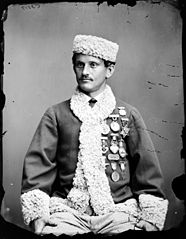
Courtesy of Wikimedia Commons.
Jackson Haines is often credited with inventing modern figure skating. American by birth, he traveled to Europe in the 1860s and performed in various countries. His skating proved particularly inspirational to the Viennese. There, dancing on ice took off and, going down a long and twisty path, eventually resulted in today’s figure skating. The focus of this post is on his skates.
Haines’ first stop was London. On September 3, 1864, Bell’s Life in London and Sporting Chronicle noted his arrival of Jackson Haines:
Mr Jackson Haines, the champion skater of America, has just arrived in this country with a view of giving us a taste of his qualities. It might seem strange that he should have selected this time of year for his exhibitions did we not know that he is quite as much at home on terra firma, with his parlour skates, and can accomplish as many tours de force as he can in ordinary skates on the ice. Mr Haines is in treaty for an engatement with several London managers, and, we doubt not, will shortly be before the public.
Bell’s Life in London and Sporting Chronicle, Saturday, September 3, 1864, p. 8.
What were these “parlour skates”? A later article clarifies:
The patent skate used by Mr. Haines runs on three indiarubber wheels, and the effect under his sway was almost to lead the spectator to believe the Palace was an ice-house and the platform in front of the Shakespere-house frozen over. The rapidity with which he moves in his dances is exceedingly pleasing, and indeed marvellous.
Express (London), Tuesday, September 27, 1864, p. 2.
Were these the first artistic inline skates? I haven’t found a picture of them, but there are some pictures of Haines on inline skates with four wheels. The fourth wheel may have been added in a later version of the design.
Incidentally, the Express‘s description of Haines’ performance as “exceedingly pleasing” and “marvellous” contrasts with the usual story of Haines’ reception in England, but that’s a story for another time.
